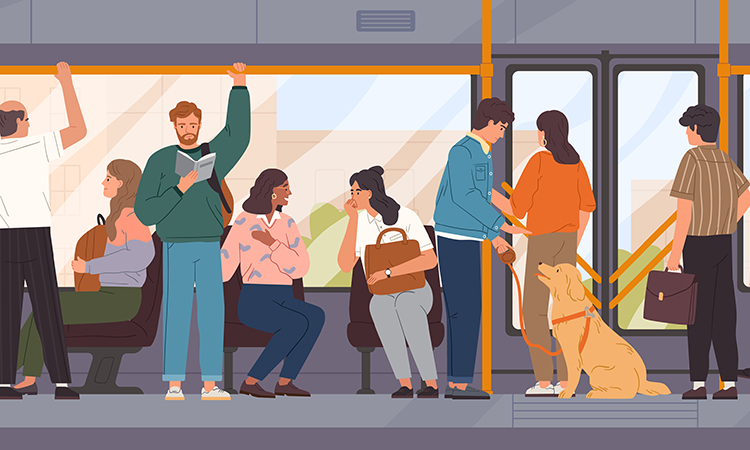Roundtable: Delivering a seamless and enjoyable passenger experience
- Like
- Digg
- Del
- Tumblr
- VKontakte
- Buffer
- Love This
- Odnoklassniki
- Meneame
- Blogger
- Amazon
- Yahoo Mail
- Gmail
- AOL
- Newsvine
- HackerNews
- Evernote
- MySpace
- Mail.ru
- Viadeo
- Line
- Comments
- Yummly
- SMS
- Viber
- Telegram
- Subscribe
- Skype
- Facebook Messenger
- Kakao
- LiveJournal
- Yammer
- Edgar
- Fintel
- Mix
- Instapaper
- Copy Link
Posted: 11 March 2022 | Angela Trainor - Nomad Digital, Kyle Rowe - Spin, M.J. Maynard - Regional Transportation Commission of Southern Nevada (RTCSNV), Marc Atkins-Turley - Stagecoach Group plc | No comments yet
This roundtable brings together key experts to discuss how the industry can work to deliver seamless and enjoyable passenger journeys in order to encourage more people to choose to travel by public transport, as well as to ensure the loyalty of those who already do.


As the public transport industry looks to increase the rate of its post-pandemic recovery by regaining passenger confidence and increasing ridership numbers, ensuring that the passenger experience is both seamless and enjoyable will be key to encouraging people back onto public transport and avoiding a car‑led recovery.
This roundtable brings together key industry personnel and those passionate about sharing their opinions on the passenger experience to discuss how the industry can work to deliver seamless and enjoyable passenger journeys in order to encourage more people to choose to travel by public transport, as well as to ensure the loyalty of those who already do.
  |
  |
  |
  |
|
Angela Trainor |
Marc Atkins-Turley |
M.J. Maynard |
Kyle Rowe |
| Product Manager, Nomad Digital | Commercial Director, Stagecoach Group plc | Chief Executive Officer, Regional Transportation Commission of Southern Nevada (RTCSNV) | Global Head of Government Partnerships, Spin |
Public transport is continually working to improve the passenger experience. Why is this so important?
By placing greater emphasis on improving the quality of the passenger experience in public transport, operators have great opportunities to retain existing passengers and, of course, encourage more people onto public transport”




On a broader level, improving the customer experience will see more people switch from their own cars to public transport – which brings other benefits, such as reducing emissions and pollution; easing congestion in towns, cities and communities; as well as reduced stress levels due to less driving on busy roads and more walking. This, in turn, has a positive impact on overall quality of life, reducing pressure on the healthcare system and, for these reasons, it is paramount that operators continue to seek to improve the passenger experience.


Urban mobility, consumer expectations and technological capabilities are evolving at an extraordinary rate and disrupting how we traditionally deliver transportation services. We need to leverage technology and forge partnerships to develop multimodal options that can create safer, more reliable and efficient transportation systems that connect people to opportunities and services, reduce congestion, improve mobility and enhance safety.
In the greater Las Vegas metropolitan region, we are engaging in pilots with advanced mobility technologies to enhance the transportation experience for transit customers and commuters. Our RTC-OnDemand micro-transit pilot provides universal service to an area of the valley that previously did not have access to fixed-route transit. Customers can get picked up from their doorstep and dropped off near multiple locations in the service zone or at a bus stop that connects them to the fixed-route system.


Passengers’ expectations are constantly changing. Currently, what are the most important features that public transport passengers are looking for during their journey?


Clearly, technology also plays a big part in supporting this personalised and frictionless travelling experience. As part of Nomad’s strategy to leverage the power of digitalisation and data, we’re focusing on using technology and innovation to provide better information. This includes initiatives such as CCTV-based passenger density sensing and optimisation to analyse crowd position, flow, sentiment and mood without tracking or personally identifying individuals. Sharing this data with passengers means that they can then make informed decisions for a safer, more comfortable and enjoyable experience. Engaging with passengers in this way also helps operators to manage passenger expectations.


We need to ensure that we communicate our processes and strategies around cleaning, hygiene and safety, much more so than we did previously”
The COVID-19 pandemic has heightened awareness around passenger expectations regarding cleanliness and safety, with individuals being more likely to ask what operators are doing to keep people safe. We need to ensure that we communicate our processes and strategies around cleaning, hygiene and safety, much more so than we did previously. However, at Stagecoach, these features have always been an important aspect of the customer journey and business model.
Value for money is another important expectation, as are simple ticketing structures, ensuring that both drivers and customers know which tickets offer the best value. Stagecoach is currently working towards fare simplification, which sees a reduction in single fares with a move to easier-to-understand zonal tickets and day tickets, so that customers can travel further and more frequently for the same price as standard returns. We have also introduced Flexi tickets for those who don’t need to travel as often as they used to.
There’s also been a more recent demand for fairer multi-operator and multi-modal ticketing to match the changes in lifestyle and commutes to make the experience as simple as possible. Other key expectations are loyalty recognition and being able to deliver services with simple, reliable digital technology options.




How does access to public transport play a role in delivering an exceptional passenger experience?


Independent research by transport consultants has consistently found that Stagecoach offers the lowest average weekly bus fares of Britain’s four main national operators. In addition, we’re also using smarter technology to provide easier journeys and are working closely with users who represent a wide variety of disability groups. All of our local bus fleets in the UK are fully accessible as a result of significant investment over many years. Stagecoach has signed a charter with UK sight loss charity the Royal National Institute of Blind People (RNIB) that commits to meeting the needs of passengers with a visual impairment. We have also worked with partners – including Guide Dogs – on “Swap with Me” initiatives to raise awareness among our employees of potential barriers to travel among excluded groups.
Accessibility plays a vital role in public transportation, in both providing service to customers as well as delivering an exceptional passenger experience”




How are digital solutions supporting public transport in making the passenger journey more seamless and enjoyable?


One of the biggest opportunities is about providing door-to-door journey information. Trains, buses, taxis, e-scooters and bikes are closely linked, and Nomad Digital is developing new services that give passengers confidence in all of the stages of their journey. This includes digital products which can be paired with trains equipped with the latest sensor technologies; advanced algorithms; and leveraging different partnership players to provide a next-generation passenger experience. For example, a journey-planning app that’s based on a common, coordinated and integrated platform to let passengers relax and enjoy the ride. An app that includes essential information, sends alerts to let passengers know when their stop is coming up and, in the case of delays or cancellations, can scan the schedules and recommend alternative routes. All of this rich data in the palm of a passenger’s hand.


However, we still have a long way to go and have big plans to take this even further for our customers. This includes increased availability of pay-as-you-go travel and daily and weekly fare capping; improved end-to-end journey planning and purchasing; and better integration between all modes of public transport and emerging mobility modes. We want to create the sort of seamless experience that can make a journey on public transport as easy as getting into a private car, which will support a shift to more sustainable modes of travel and help the UK to deliver on its carbon reduction targets on its way to net zero. However, we also have to ensure that digital solutions don’t leave anyone behind, and that public transport remains inclusive, accessible and affordable for every member of society, especially those that rely on us the most.
By integrating digital solutions into one convenient place, customers can access information and payment options easily, making their journeys more seamless and enjoyable”


RTC bus passes are also available on three other apps: Uber, Lyft and Transit. Because these platforms are so widely used, tourists who come to Las Vegas can purchase an RTC pass without downloading another app. In effect, the convenience and options inspire loyalty and repeat customers.


What were the biggest changes that had to be made in order to ensure a safe and enjoyable experience for passengers during the COVID-19 pandemic?


Communication to customers was also extremely important. We had to ensure that our communications regarding cleaning, face coverings, social distancing and timetables were as clear as possible and communicated through a variety of channels to ensure that it reached individuals using our services. This, in turn, helped to build confidence that it was safe to use public transport and that we could continue to serve communities across the UK.




As a single occupancy, open air transit solution, e-scooters became a safe way to travel to essential businesses during the pandemic. We adjusted our deployments in many cities to address a shift in rider demand and to fill the gaps left by transit service interruptions.
How can different modes of public transport collaborate in order to encourage multimodality and improve the door-to-door passenger journey?
To encourage multimodal travel, we need to make it as easy as possible for customers to combine different modes of transport and communicate the benefits of doing so in a seamless way”


This means making it easy for customers to plan their journey. For example, through an end-to-end journey planner, ensuring that they can buy a ticket that offers great value for money across the different modes of transport whilst operators make sure that timetables work for the most common multimodal journeys. By working together, this will enable customers to readily transfer from one mode of transport to another without having to walk too far or rely on a private car or taxi.
However, bus operators alone can’t deliver this – we need all of the relevant transport providers to come together to collaborate, and we need the support of local and national government to develop the timetable, ticketing systems and physical infrastructure that we will need.




Related topics
COVID-19, Journey Planning, Mobility Services, Multimodality, On-Demand Transport, Passenger Accessibility, Passenger Experience, Public Transport, Ticketing & Payments, Travel & Passenger Information
Issue
Issue 4 2021
Related organisations
Nomad Digital, Regional Transportation Commission of Southern Nevada (RTC), Spin, Stagecoach Group
Related people
Angela Trainor, Kyle Rowe, M.J. Maynard, Marc Atkins-Turley







